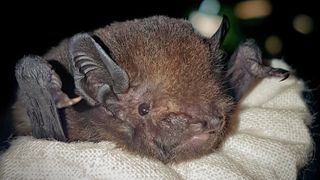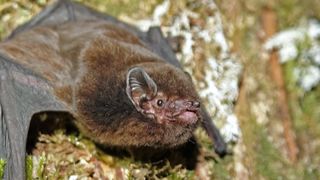Fowl play? 'Bird of the Year' winner in New Zealand contest is a bat
The winner by a nose (not a beak) was pekapeka-tou-roa, also known as New Zealand's long-tailed bat.

When is a bird not a bird? When it's a bat, according to a New Zealand contest that just named a highly endangered bat "Bird of the Year."
Pekapeka-tou-roa, or New Zealand's long-tailed bat (Chalinolobus tuberculatus), weighs about 0.4 ounces (11 grams) and a fully grown adult is about the length of a human thumb. This species of pekapeka — the Māori word for bat — was once common in New Zealand but is now exceptionally rare, representatives with Forest and Bird, a New Zealand conservation group and organizers of the contest, said in a statement.
For two weeks, nearly 57,000 voters weighed in on selections for New Zealand's top bird; this year, for the first time in the contest's 16-year history, their choices included a mammal. Contest organizers added the long-tailed bat to the lineup to raise awareness about the species' endangered status, and it quickly flew to the top of the list with 7,031 votes, Reuters reported. Trailing behind in second place with 4,072 votes was the kākāpō (Strigops habroptilus), a tubby, flightless bird that's also known as an owl parrot.
Related: In photos: The eerily beautiful bats of Arizona
"The campaign to raise awareness and support for this little flying furball has captured the nation," Bird of the Year spokesperson Laura Keown said in a statement. "A vote for bats is also a vote for predator control, habitat restoration, and climate action to protect our bats and their feathered neighbours," she said.
Long-tailed bats now join other Bird of the Year winners — all birds — that are also iconic animal ambassadors for New Zealand. They include the kākāpō; the yellow-eyed penguin (Megadyptes antipodes); and a colorful pigeon called the kererū (Hemiphaga novaeseelandiae), to name just a few, according to the contest website.

Bats are the only land mammals that are native to New Zealand — all others were introduced by humans — and there are three species: the long-tailed bats, and two species of short-tailed bats, according to Bat Conservation International (BCI). The short-tailed species, Mystacina robusta and M. tuberculata, are the most terrestrial of all known bat species, a behavior that may have evolved over millions of years because New Zealand lacked terrestrial predators for much of its history, according to BCI.
Sign up for the Live Science daily newsletter now
Get the world’s most fascinating discoveries delivered straight to your inbox.
But bat populations in all three species began to disappear when people first settled New Zealand about 1,000 years ago, introducing dogs and rats as the continent's first mammalian predators. The bats' decline then accelerated with the arrival of European colonizers, around 140 years ago. Today, M. robusta is thought to be extinct, and the remaining species are at risk and will likely vanish unless invasive predators such as possums, rats, stoats and cats can be better managed, according to the New Zealand Department of Conservation (DOC).
Other threats to the newly-minted Bird of the Year and its short-tailed bat cousins include habitat loss, as trees in their forest homes are chopped down for firewood and lumber, and to clear ground for agriculture, according to the DOC.
While the long-tailed bat's designation as Bird of the Year has ruffled some feathers, the contest organizers stand behind their choice.
"In New Zealand we believe in the underbird," contest representatives said in the statement. "We believe that where you come from doesn't have to determine your future."
Originally published on Live Science.

Mindy Weisberger is an editor at Scholastic and a former Live Science channel editor and senior writer. She has reported on general science, covering climate change, paleontology, biology and space. Mindy studied film at Columbia University; prior to Live Science she produced, wrote and directed media for the American Museum of Natural History in New York City. Her videos about dinosaurs, astrophysics, biodiversity and evolution appear in museums and science centers worldwide, earning awards such as the CINE Golden Eagle and the Communicator Award of Excellence. Her writing has also appeared in Scientific American, The Washington Post and How It Works Magazine. Her book "Rise of the Zombie Bugs: The Surprising Science of Parasitic Mind Control" will be published in spring 2025 by Johns Hopkins University Press.
Most Popular


